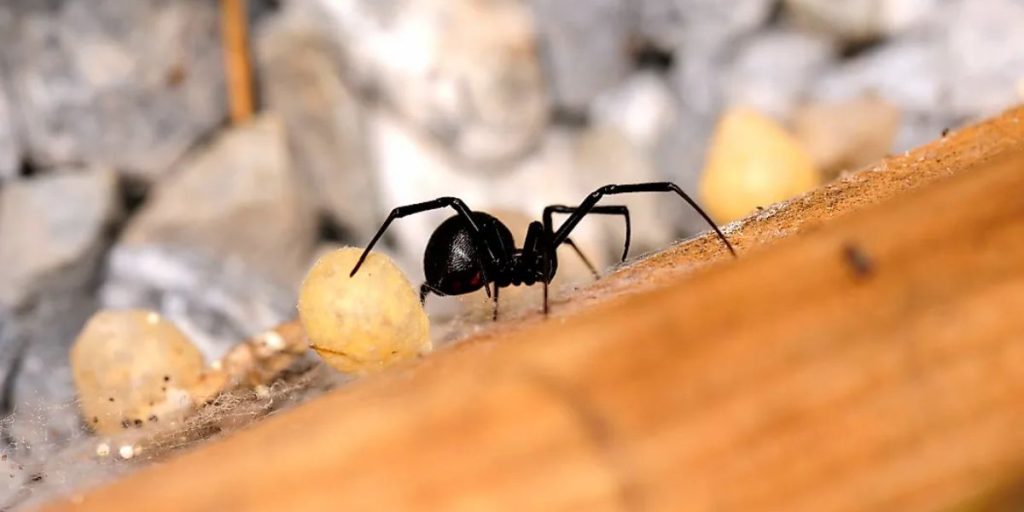California has several deadly spider species. Most spiders are harmless and even help manage pest populations, however the Western black widow, several recluse species, and other spiders like the brown widow and brown recluse can bite humans.
Staying safe and recognizing these spiders’ function in the ecology requires knowing where they reside, their habits, and how to treat bites.
Western Black Widow
Western black widows are prevalent in California’s urban, suburban, and rural settings, especially in dry, protected garages, sheds, and under garbage. The spiders create uneven webs around ground level in places with little human disturbance. Their shiny black bodies, round abdomens, and red hourglass markings on females’ undersides distinguish them. Western black widows are nocturnal and feed on flies, beetles, and other tiny arthropods captured in their webs. Although females may bite when guarding their eggs, they are usually non-aggressive and will retreat.
Western black widow venom contains latrotoxin, a neurotoxin that disrupts nerve transmission and causes muscle pain, cramping, and localized sweating. Bites can cause nausea, vomiting, and high blood pressure. In severe situations, respiratory problems or paralysis can occur. Children, the elderly, and those with pre-existing problems should seek medical assistance immediately if bitten. Ice on the bite and elevating the limb might relieve discomfort until medical care arrives.
Desert Recluse
In Southern California’s arid conditions, desert recluses seek dry, undisturbed woodpiles, rock crevices, and storage niches. Unlike other reclusive species, it thrives outside yet may seek sanctuary in homes. Due to its drab appearance, desert recluses are hard to spot, but their violin-shaped back markings help. Shy nocturnal hunters, these spiders eat crickets, ants, and other arthropods. They are shy and only bite when threatened.
Desert recluse venom is cytotoxic, destroying tissue at the bite site. The bite may be harmless at first but become a painful, necrotic lesion within hours. Redness, swelling, and an open ulcer may occur with fever, chills, or nausea. Rarely, severe cases can cause systemic consequences. Clean the area, use ice, and seek medical assistance for surgery if tissue damage is severe.
Read More: Notoriety on Peak: 7 Prisons in California with a Grim Reputation
Chilean Recluse

Chilean recluses have spread to California, especially in densely populated places like Los Angeles. Attics, basements, and beneath furniture are ideal for these spiders, who live in human homes unnoticed. Its back features a violin-shaped marking like other recluse species, however the Chilean recluse is larger than the desert recluse. They hunt little insects at night and rarely interact with humans unless their habitat is damaged.
The Chilean recluse’s cytotoxic and hemolytic venom can kill red blood cells and tissue around the bite. Untreated bites can cause huge necrotic sores and, in rare cases, kidney failure, convulsions, or death. Pain, swelling, and redness around the bite precede blistering and ulceration. Initial therapy may include wound care, antibiotics, and, in severe situations, surgery to remove necrotic tissue.
Brown Widow
In urban California, the brown widow spider lives under patio furniture, garages, and eaves in sheltered, low-traffic locations. Brown widows are more visible during the day than black widows. Brown widows have lighter brown or tan bodies with orange or yellow hourglass marks under their abdomens. Brown widows feed on flies and mosquitoes in their irregular, sticky webs. They are non-aggressive yet will bite to safeguard their egg sacs.
Brown widow venom is neurotoxic but less effective than black widow. A bite can cause regional discomfort, muscle stiffness, and cramping for hours or days. More acute symptoms including nausea, perspiration, and increased blood pressure are fewer and less severe than black widow envenomation. Most bites do not require medical treatment, but ice and medical guidance can relieve pain. Severe instances may require antivenom or hospitalization.
Baja Recluse
The desert recluse’s close relative, the Baja recluse, lives in southern California, especially near Mexico. This species likes dry, undisturbed places like rocks, woodpiles, and dwellings. The Baja recluse has a violin-shaped marking on its back, but its size and coloration make it hard to differentiate from other recluse spiders.
The Baja recluse’s cytotoxic venom can destroy tissue at the bite site. Pain, swelling, and necrotic lesions that take weeks to heal are symptoms. Systemic consequences include fever, muscular soreness, and nausea. Rare severe reactions include renal failure or subsequent infections. In severe cases, surgery may be needed to remove injured tissue. Wound care and medical therapy should begin immediately.
Also Read: Wealth Haven for the Rich: Discover the Eight Wealthiest Counties in California
Brown Recluse
Brown recluses are endemic to the Southeast but have been found in California. In dark, undisturbed places like basements, closets, and attics, these spiders can hide. The brown recluse has a violin-shaped marking on its back and a basic brown look like its relatives. They hunt little insects at night and avoid humans unless disturbed.
Brown recluse venom is known to cause necrotic bite wounds. Bites are normally painless but can become ulcers with redness, swelling, and tissue collapse. Rarely, fever, chills, and nausea may occur. Emergency medical care is needed to treat the wound and avoid tissue damage. Treatment may include wound care, antibiotics, and necrotic tissue excision in severe situations.
Summary
Venomous spiders in California are scary, but most bites are avoided with caution. Spiders avoid humans and only bite when provoked or threatened. Californians can coexist with these arachnids without harm by studying their habitats and behaviors.
For more deadly species, immediate medical assistance is recommended after a bite. With respect for their function in nature and sufficient measures, these spiders can be properly managed.